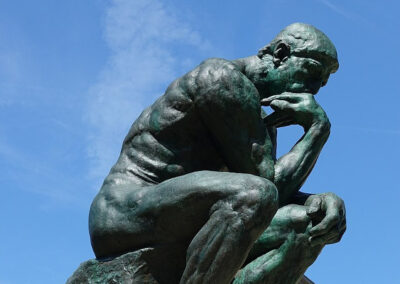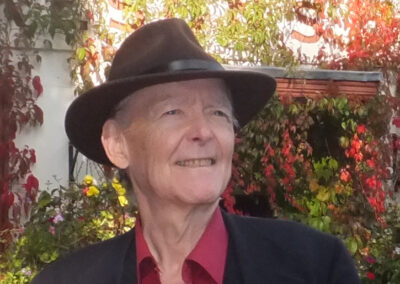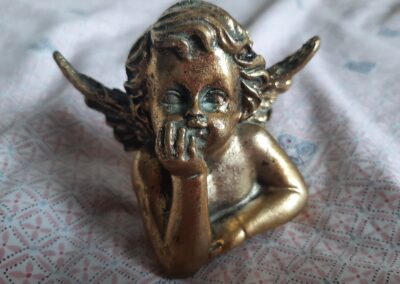Reflections as in a Mirror
Reflection, so the robotically inclined tell us, occurs in written English 30 times in every million words. The Masters-of-the-Universe-To-Be (A.I.) do not however tell us how many of the 30 are related to reflections as in a mirror as against reflections in the mind. Is there something they know and we don’t? What is below may suggest s starting point for thinking about this meaning of ‘reflection’.
A reflection in a mirror enables us to see ourselves as others see us and may tell us a little about what we are thinking; a very little it would seem. As King Duncan put it in Macbeth: ‘There is no art to find the mind’s construction in the face.’ A school of thought suggests that much else connects the two types of ‘reflection’ though, to many of a matter-of-fact turn of mind, reflections in a mirror give an idea of what is in front of the mirror but appearance is not the reality. To reflect is a subjective exercise. The mirror image may look the same to an onlooker as the gazer into it but the subject is different in their subjective way of looking out at the world. Similarity of words is deceptive; being objective about a reflection is not to objectify the gazer in the mirror or present him as ‘an object’.
Symbolic interpretation of this meaning of the word ‘reflection’ may give a matter-of-fact thinker some matters of fact, or at least ‘concepts’, to think about.
In Plato’s Cave, the flickering shadows on the wall – of the fire outside the cave that was never seen by the cave dweller – might not have been in a mirror as such but were suggestive of reality. They were a means of seeing that there was a type of reality, in this case, a fire, even if it never took light, so to speak, in the actual cave. A reflection of what can exist may have its uses as well as its intrinsic interest. Men have been trying to get at ‘the truth’ in all manner of contexts for aeons even if decoding evidence of what is ‘out there’ is largely limited by our five senses.
Janine, an art therapist, in the interview linked herewith is fascinated by reflections in a mirror and says why.
Brian Mayne writes in ‘Who Am I?’
“A Zen master, Robert Aitken Roshi, spoke of the world as a hologram on our senses. A hologram is a three-dimensional image made by interference of beams from a coherent light source. This could be heard as another way of saying the world and all the rest of manifested reality can be likened to an illusion projected by a ‘light’ source from within us and reflected on our senses. Who we are must be the unchanging reality behind the senses, witnessing the illusion/maya, or ‘relative reality’ of changing manifested creation.“
The Empty Mirror is a fascinating tale about life in a Zen Monastery by Janwillem van der Wetering who explores the symbolism further. The Chapter on Page 121 : A court lady discourteously treated is about a reflection in a mirror.
Brian writes about this book: ‘What the Hall of Mirrors is saying – as far as I understand it – is that we almost never experience reality, but project our memories, associations, preconceptions, likes, dislikes, judgements, etc. on what we experience, which is then reflected back to us. So someone who feels a victim will interpret situations are victimising them.’
The earlier that young people are familiarised with the concepts about ‘reflection’ the better. In a tale for children, Scheherazade, Dan Remenyl writes about a Magic Mirror.
Mirror hanging on the Wall
Mirrors me through it
Situating the Self there that I see
As Myself, that I
Never see in the ordinary
Run of the Day.
That makes me wonder
About this I, which I
Do not normally do.
Self and Not Self
Duality : It is
Now brought to the Mind
Somewhere there, then, Mirror, Mirror show
Me what Real, is behind, anchoring it, All
Transcription
Interviewer: it would be helpful if you showed on your mobile a painting that you’re just doing and explain the significance of reflections to you.
I’m doing painting from life is because I’m perceiving the world visually, that is my understanding, and translating what I’m seeing in paint and canvas with the brush as the tool and the colours. I experience it as the most challenging work that I’ve ever done because there is a lot of resistance to standing in front of the easel and painting from life … lots and lots of things get in the way, which are much more interesting especially if you’re doing a painting from life and you keep going back to it – because it’s the process of putting yourself back into the same position each time in order to continue the painting.
I was very inspired by Lucian Freud when I went to his exhibition several years ago because he used to have a painting in the morning with a model, a painting in the afternoon with another model, and a painting in the evening with another model. He would keep coming every day and do a bit more of the painting. It’d be the same pose and it would take a few years so to continue to look at the same thing again and again and again. It is a real challenge but the practice of doing it is that every time you look at the same thing and try and translate what you’re seeing into paint and colour and shape and a form and line and whatever is makes up this translation. It’s your experience of what is in front of you, so it’s your experience of existing and being and perceiving where you are in the physical world, the material world, so it’s the ‘me’ and the ‘not me’ meeting the ‘me’ and the ‘not me’. There was a turn of phrase of phrase used in infant psychology: when the child when there’s a baby, infant, toddler, child, the theory is that the baby is everything – everything’s in the experience of the baby, and then there’s the gradual way that life puts in the way everything. To say ‘actually I don’t want that to happen’ and that what I thought was ‘me’ has just walked out the room. I’m not saying ‘how can I do that’ so it begs the question ‘where has that part of me gone?’ There’s a panic then the mother comes back and then everything is repaired. So that you – the baby or the infant – gets the experience of continuity with gaps. But the guts are okay. You know they survive and then you know they’re one with the mother again, but they eventually realize that actually this part of them is actually ‘not them’. That’s a maturity, with narcissism. Maturity isn’t reached so everything is still an appendage of the person.
I’m going down ‘a rabbit hole’ there but the main thing is that that’s the ‘me’ and the ‘not me’ – and if you see the reflection then in the mirror – maybe your own reflection, or somebody else looking at their reflection, is that the same sort of ‘not me’ that’s in the reflection. That could be taken away. That is how you see it. It’s a reflection of yourself.
How cute was Freud’s last Narcissus! He looked at the Greek legend Narcissus, the boy looking into the pool seeing himself and falling in love with himself – I don’t know the exact details of the legend but – he saw it as a description of that phase of self-love. The world revolves around that person and they are the King or Queen of their domain but it’s only through the separation from that, that you can start to feel that you are part of a bigger World rather than your being the world. It’s more than that and there are no separations….
Interviewer: Are you suggesting then the one looks at the reflection and throws into that reflection ideas which one has oneself but which, as it were, you’re grafting on to a reflection, a sort of preconception that might just be only yours? How would you actually see a reflection of yourself when you were looking at your reflection? What would that tell you about you?
I couldn’t afford a model so the next best thing was myself in the mirror just to just to paint a figure rather than a room. so that was the practical start of it. But then the more you do it, it becomes more of a philosophical Challenge. It was, really, to do the reflection of yourself in the mirror within the context of the studio. Self-portraits are often just self-portraits, so you don’t see the edge of the mirror, you don’t see the studio behind the mirror, you don’t see the easel and the painting. You just see the self-portrait. So many artists have done self-portraits because there’s no model around; maybe and they want to do a human face but as soon as, once, you try and think about the context of that reflection, it’s actually a mirror with a frame and then the mirror with the frame is within the context of the room, within the context of the rest of the world; it’s that in a sense you’re challenging your perception of yourself in the world.
He’s (…) going to show a development over the several years from the canvases but first of all it would have been the self-portrait, it was the self-portrait, then it was the self-portrait with the mirror frame, then it was the self-portrait with the mirror frame and the studio, then the self-portrait the mirror frame, the studio and the canvas with the painting on it. and then within that canvas it’s the canvas within the canvas. You have the canvas within the canvas within the canvas so literally you can see three images of the artists standing looking at their reflection in the in the mirror but in the one painting. It’s absolutely mind-boggling and it’s really difficult practically to know how to paint it. I sort of get lost in this morass of the real, the imaginary, and the symbolic. Because the real is the actually the real, actual background, …behind the easel stands the canvas, and the mirror and the frame, the stand that’s all the ‘Actual’. Then you start painting the reflection, which is slightly different because the reflection has got different lighting from the background. So it’s ‘although they’re this’ it’s maybe the same object, and there’s different tones of lighting. So then when you start painting the canvas then you can mistake which one you’re doing, so it’s actually quite mind-boggling what it’s getting into…..what we know, how we experience the world with our brain, and our senses.
We’re at the interface of something here which is really very challenging. An analogy might be that you a sailor in, say, a rowing boat on the sea and you can’t see any land but you’ve got the belief that you’re going to get somewhere on dry land and you know you’ll survive the journey, but in the meantime you’re there with the elements, having to deal with the hot sun, the storms. You know what’s going to tip the boat over, what’s going to help you get along, like food supplies, so you know it’s about survival. So maybe the painter’s challenge or the artists challenge or the writer’s challenge is surviving that Journey and not bailing out. You know are staying in that boat because that’s where you’re going. That’s going to carry you along and you are trusting in that boat and the supplies and the sail and the oars, all the tools of the trade, be it composer or the choreographer. I think, all the Arts. Basically, they’re composers of something to do with all the scenes. You know their expressions of human senses and intelligence, you know the brain, the thinking that set the thinking, and understanding of a sensory world. We’ve got a mental world, and a sensory world. We can bring something from nothing.
Leonard Cohen (in his songs) brings something from nothing, so creating something in the world that wasn’t there before…. the art therapist creates the safe space and by that I mean a prepared set of art materials, carving out the time you’re supposed to be ‘here’, from this time to this time, and the reason for you being here is to engage with the art materials and see what happens when you put pen to paper or paint to paper, see what comes, what happens. The art therapist is there to hold that space and believe in it. You believe that this is something which may help you (the person having the art training or therapy) connect with your own experience of the world – not through interacting with the therapist verbally, necessarily, but by being somewhere where you feel that person isn’t going to intrude but is there. They might just be sitting there or they may be doing some doodling themselves that it’s there for you to make contact with yourself through art materials and other arts therapies.
You can do it through music, dance, drama. I’m not professional in those other Arts but the basis is that the person becomes an agent, their own agency. You know it encourages someone to have their own agency, their own thoughts, their own marks. It can be likened to a psychiatrist – of whom the best sort is the one who doesn’t speak (with a name) but enables you to find your own voice. It’s about finding that voice because we listen to others. Other people want us to do things; they want us to think this, do that. In order to k drive a train you have to drive a train for other people so you’re the agent of the train or the train company, you’re not your own agent. It’s about bringing people back to being their agents and have their own agency.
The basis of any psychoanalysis or Psychotherapy or art therapy is to help people get back on their own horse, so to speak, which they probably fell off as a child.







